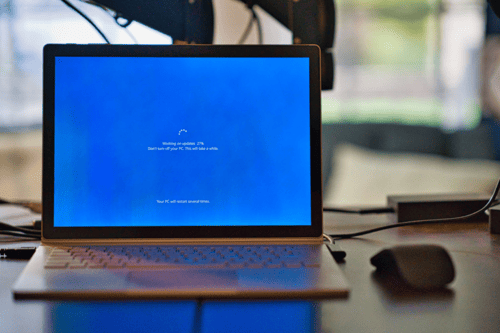
Managing Your Technology Risk
Estimated Reading Time: 3 Minutes
Today, no business is 100 per cent secure from cyber threats, and more companies are waking up to this reality now than ever before. It’s no wonder cybersecurity investment in 2020 is pegged to grow by 5.6 per cent to reach nearly $43.1 billion in value. With cyberattacks surging due to widespread remote work and increased online interactions during the pandemic, it seems likely that this trend will only continue to grow further.
Download your Risk Register Sample at the end of this article.
While 58 per cent of IT leaders and practitioners consider improving IT security their topmost priority, nearly 53 per cent of them find cybersecurity and data protection to be among their biggest challenges as well. That’s primarily because cybersecurity is not a one-and-done exercise. Your business might be safe now but could be unsafe the very next minute. Securing your business’ mission-critical data and customers’ data requires undeterred effort sustained over a long period of time. While there are several pieces to this puzzle, the most important one, considering today’s threat landscape, is ongoing risk management.
Through the course of this blog, you will understand the definition of a cybersecurity risk assessment and why you must undertake and monitor them regularly to keep your business’ cybersecurity posture abreast with ever-evolving cyber threats. By the end of it, we hope you realize how installing cybersecurity solutions alone isn’t enough to counter cyber attacks unless you make ongoing risk management an operational standard for your business.
Understanding Cybersecurity Risk Assessment
In rudimentary terms, a cybersecurity risk assessment refers to the act of understanding, managing, controlling and mitigating cybersecurity risks across your business’ infrastructure.
In its Cybersecurity Framework (CSF), the National Institute of Standards and Technology (NIST) states that the purpose of cybersecurity risk assessments is to “identify, estimate and prioritize risk to organizational operations, assets, individuals, other organizations and the Nation, resulting from the operation and use of information systems.”
The primary purpose of a cybersecurity risk assessment is to help key decision-makers take informed decisions to tackle prevalent and imminent risks. Ideally, an assessment must answer the following questions:
- What are your business’ key IT assets?
- What type of data breach would have a significant impact on your business?
- What are the relevant threats to your company and their sources?
- What are the internal and external security vulnerabilities?
- What would be the impact if any of the vulnerabilities were exploited?
- What is the probability of a vulnerability being exploited?
- What cyberattacks or security threats could impact your business’ ability to function?
The answers to these questions will help you keep track of security risks and mitigate them before disaster strikes. Now, imagine periodically having the answers to these questions whenever you sit down to make key business decisions. If you’re wondering how it would benefit you, keep reading.
Why Make Ongoing Risk Management an Operational Standard?
Making ongoing risk management an operational standard is vital, especially in today’s cyberthreat landscape where even a single threat cannot be underestimated. In one assessment, your business might seem on the right track, but in the next one, certain factors would have changed just as the company would have changed. That’s precisely why having an ongoing risk management strategy is now an integral part of standard operations for many of your peers.
Here are seven reasons why you can’t keep this critical business decision on the backburner anymore:
Reason 1: Keeping Threats at Bay
Most importantly, an ongoing risk management strategy will help you keep threats, both prevalent and imminent, at a safe distance from your business – especially ones you usually do not monitor regularly.
Reason 2: Prevent Data Loss
Theft or loss of business-critical data can set your business back a long way, leading to the loss of business to competitors. Ongoing risk management can help you remain vigilant of any possible attempts at compromising your business data.
Reason 3: Enhanced Operational Efficiency and Reduced Workforce Frustration
As a business owner or key decision-maker of your organization, you would be amazed how consistently staying on top of potential cybersecurity threats can reduce the risk of unplanned downtime. The assurance that hard work will not vanish into thin air will surely keep your employees’ morale high, thereby reflecting positively on their productivity.
Reason 4: Reduction of Long-Term Costs
Identifying potential vulnerabilities and mitigating them in time can help you prevent or reduce security incidents, which in turn would save your business a significant amount of money and potential reputational damage.
Reason 5: One Assessment Will Set the Right Tone
You must not assume that there should only be one fixed template for all your future cybersecurity risk assessments. However, in order to update them continuously, you need to conduct one in the first place. Hence, the first few assessments will set the right tone for future assessments as part of your ongoing risk management strategy.
Reason 6: Improved Organisational Knowledge
Knowing security vulnerabilities across the business will help you keep a keen eye on important aspects that your business must improve on.
Reason 7: Avoid Regulatory Compliance Issues
By ensuring that you put up a formidable defence against cyberthreats, you will automatically avoid hassles for complying with regulatory standards such as HIPAA, GDPR, PCI DSS, etc.
Continue tackling the Risk – Download your Risk Register Sample

From our years of experience working with customers in highly regulated industries – Financial Services, Healthcare, semi-private organisations – we have found that the best way to handle the challenges of managing technology risk and governance is by leveraging the NIST Cyber Security Framework.
We explain how to do it in detail in our Guide to NIST. Its main focus is for Financial Services companies, but every type of business can leverage the framework to deal with risk.
Download your Risk Register Sample Here.
The Asset and Risk Register are crucial for the development of a Risk management system, but keep in mind that they are only part of that system and not the end result. Now that you are done reading this part, the next one is to Develop your Action Plan to Address Technology Risk.
To continue managing the risk consistently and continually, we have developed our own methodology to assist and guide you through every step. If you are looking for an extra level of detail and a system that will make this process much more comfortable and straightforward, Book a Call with us. We can get you to your desired state of maturity with a tested solution.
Follow us on Social Media for more exclusive content, and as always, if you have any feedback or questions about this article, please do not hesitate to use the comment box below.

